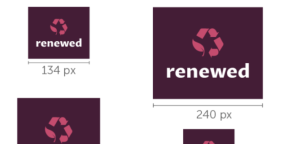Are you curious about the iconic yellow rectangle that captures the world’s attention? We’re talking about the National Geographic logo. The logo is a testament to the brand’s growth and expansion over the years. It’s a simple yet powerful symbol that reflects the organization’s commitment to exploring and documenting the world around us.
Designing a brand logo can be a challenging process, but it can also be incredibly fulfilling. The National Geographic logo is a great example of this. The logo’s evolution over the years has been a journey through nature and adventure, reflecting the brand’s mission to inspire people to care about the planet. The addition of the yellow border in the 1950s became a defining element of the logo’s identity, making it instantly recognizable around the world.
History of the National Geographic Logo
You might recognize the iconic yellow rectangle with the bold, all-caps letters that spell out “National Geographic.” But did you know that the logo has undergone several changes since the brand’s inception in 1888?
The first National Geographic logo arrived in 1997. It was a simple design, with left-aligned text and the iconic yellow rectangle. The letters were written in all caps, and the rectangle was a symbol of the brand’s commitment to exploration and knowledge.
From 1997 to 2001, the logo underwent several variations. The most significant change was the addition of the globe illustration within the rectangular frame. This subtle change symbolized the brand’s commitment to global exploration and knowledge.
In 2002, National Geographic unveiled its current logo, which is a modernized version of the original design. The yellow rectangle is still present, but the letters have been slightly modified to create a more contemporary look. The logo’s font is now more streamlined, and the globe illustration has been removed.
Overall, the National Geographic logo has remained a symbol of exploration, knowledge, and adventure for over a century. It has undergone several changes, but its iconic yellow rectangle and bold lettering have remained a constant reminder of the brand’s commitment to exploring the world and sharing its wonders with the public.
Design Elements of the National Geographic Logo
National Geographic’s logo is one of the most recognizable logos in the world. It has undergone several changes throughout the years, but it has always maintained its iconic yellow rectangle. In this section, we will explore the design elements that make up the National Geographic logo.
Color
The National Geographic logo is characterized by its bright yellow color. The yellow color was introduced in the 1950s and has since become an integral part of the logo’s identity. The color is associated with the brand’s adventurous and exploratory spirit. It is also used to symbolize the sun, which represents light, warmth, and energy.
Typography
The National Geographic logo features a sans-serif typeface that is bold and clean. The typeface is written in all caps, which gives it a strong and authoritative look. The font is easy to read, which makes it perfect for the brand’s publications and website. The font is also used consistently across all National Geographic materials, which helps to reinforce the brand’s identity.
Iconography
The National Geographic logo is made up of two elements: the yellow rectangle and the text. The yellow rectangle is elongated and has become an iconic symbol of the brand. It is used to represent the brand’s focus on exploration and adventure. The text is left-aligned and is written in all caps. The text is placed to the left of the rectangle and is used to identify the brand.
In conclusion, the National Geographic logo is a perfect example of how a logo can represent the identity and values of a brand. The logo’s design elements, including its color, typography, and iconography, work together to create a strong and recognizable brand identity.
Evolution Over Time
The National Geographic logo has undergone several changes since its inception in 1888. The logo has evolved to reflect the changing times while still maintaining its identity as a reputable source of geographic knowledge. Here is a brief overview of the logo’s evolution over time:
1888 – 1905
The early National Geographic logo featured a simple yet elegant design. It consisted of a rectangular frame with the words “National Geographic Society” written in a classic serif font. The design conveyed a sense of sophistication and professionalism, establishing the brand as a reputable source of geographic knowledge.
1905 – 1950s
In 1905, the logo underwent a significant change. The rectangular frame was replaced with a circular emblem featuring a globe with latitude and longitude lines. The words “National Geographic Society” were written in a bold font around the circumference of the emblem. This new design reflected the society’s focus on exploration and discovery.
1950s – 1967
In the 1950s, the logo was simplified to a yellow rectangle with the words “National Geographic” in bold red letters. This design change coincided with the society’s shift towards photography and visual storytelling.
1967 – present
The modern National Geographic logo was introduced in 1967 and has remained largely unchanged since then. The logo features a yellow rectangle with the iconic yellow border, which was inspired by the trademarked cover of National Geographic magazine. The word “National” is written in bold letters above the border, and the word “Geographic” is written below in a smaller font. This design reflects the society’s continued focus on exploration and storytelling through photography and visual media.
Overall, the evolution of the National Geographic logo reflects the society’s commitment to exploration and discovery, as well as its ability to adapt to changing times while maintaining its identity as a reputable source of geographic knowledge.
Impact and Recognition
The National Geographic logo is one of the most recognizable logos in the world. The simple yellow rectangle has become synonymous with exploration, adventure, and discovery. It inspires instant recognition of the brand, sometimes even without the wordmark. The logo has been in use for over a century and has become an iconic symbol of the National Geographic Society.
The impact of the National Geographic logo is evident in the brand’s success. The logo has helped to establish National Geographic as a leader in the field of exploration and adventure. The brand is known for its unparalleled commitment to discovering the wonders of our planet. The logo has played a significant role in creating and maintaining the brand’s reputation.
The recognition of the National Geographic logo is a testament to its design. The logo is simple, yet powerful. It is a perfect representation of the brand’s values and mission. The yellow rectangle is instantly recognizable, even from a distance. The logo is so well-known that it has become a cultural icon. It has been featured in movies, television shows, and even on clothing.
In conclusion, the National Geographic logo has had a significant impact on the brand’s success and recognition. The logo’s simplicity and power have made it one of the most recognizable logos in the world. It has become a cultural icon and a symbol of exploration, adventure, and discovery. The National Geographic logo is a perfect representation of the brand’s values and mission.
Usage and Guidelines
If you’re planning to use the National Geographic logo, it’s important to follow the guidelines to ensure proper usage. The logo is a registered trademark and is protected by law. Here are some guidelines to follow:
Logo Usage
- Always use the official National Geographic logo. Do not alter or modify the logo in any way.
- Use the logo in its original colors. The colors are Pantone 1805 red and Pantone Cool Gray 11.
- Ensure that the logo is legible and clear. Do not use the logo in small sizes or on busy backgrounds.
- Use the logo only in the context of promoting National Geographic or in partnership with National Geographic.
Trademark Usage
- Do not use the National Geographic logo in a way that implies endorsement or sponsorship by National Geographic.
- Do not use the National Geographic logo in a way that is misleading, defamatory, or disparaging.
- Do not use the National Geographic logo in a way that infringes on National Geographic’s intellectual property rights.
Contact Information
If you have any questions about logo usage or trademark usage, please contact National Geographic’s Support Center. They can provide you with additional information and guidance.
Controversies and Criticisms
While National Geographic is known for its stunning photography and informative articles, the brand has not been without its share of controversies and criticisms.
One of the most significant criticisms of National Geographic is its past history of racism and cultural insensitivity. In 2018, the magazine published an issue titled “The Race Issue,” which aimed to confront its racist past and acknowledge its role in perpetuating harmful stereotypes. However, some critics argued that the issue fell short in truly addressing the harm caused by the magazine’s past coverage.
Another controversy that National Geographic faced was its decision to feature Dr. Jan Pol, a Michigan veterinarian, on its show “The Incredible Dr. Pol.” Pol was fined and placed on probation for negligence and incompetence, which led to calls for National Geographic to remove him from the show.
In addition, some critics have accused National Geographic of perpetuating a “white savior” narrative in its coverage of cultures and communities outside of the Western world. The magazine has been criticized for presenting Westerners as heroes who are “saving” or “discovering” other cultures, rather than acknowledging the agency and contributions of people from those cultures.
Despite these criticisms, National Geographic has taken steps to address its past mistakes and improve its coverage. The magazine has implemented diversity and inclusion training for its staff and has made a conscious effort to feature more diverse voices and perspectives in its coverage.
Future of the National Geographic Logo
As National Geographic continues to expand its reach and explore new territories, the future of its logo is an exciting prospect. Here are some potential directions that the brand could take with its iconic yellow rectangle:
- Interactive Elements: With the rise of interactive technology, National Geographic could incorporate more dynamic elements into its logo. Imagine a yellow rectangle that responds to touch or changes color based on the environment it’s in.
- Sustainability Focus: As the world becomes more environmentally conscious, National Geographic could emphasize its commitment to sustainability through its logo. This could include incorporating eco-friendly materials or using the logo to promote green initiatives.
- Global Expansion: National Geographic is already a global brand, but it could continue to expand its reach through its logo. This could include incorporating more languages or cultural elements into the design.
- Digital Integration: With more and more people consuming media digitally, National Geographic could explore ways to integrate its logo into the digital space. This could include creating a digital version of the yellow rectangle that can be used across social media and other online platforms.
Whatever direction National Geographic takes with its logo, one thing is certain: it will continue to be a powerful symbol of exploration, discovery, and adventure.
Marietta Arnold is a branding and design enthusiast who draws inspiration from hobbies like hiking, photography, and art exploration. With a background in graphic design, she shares insights on branding strategies and logo design trends. Stay updated with Marietta’s work for the latest in branding and design.



